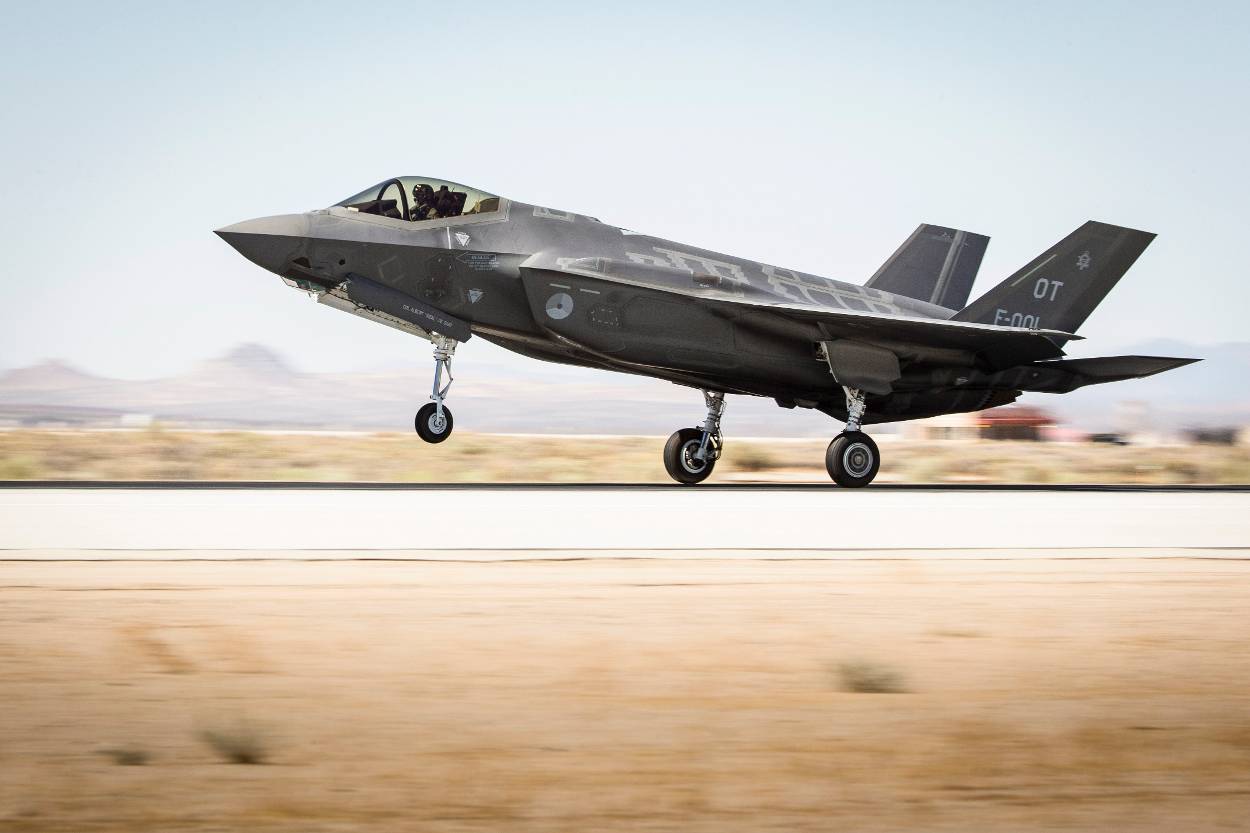On March 29, Dutch F-35s replaced F-16s in the Quick Reaction Alert (QRA) detachment guarding the airspace above Belgium, the Netherlands, and Luxembourg, marking a gradual step towards the retirement of the Fighting Falcons.
The two F-35s from the Royal Netherlands Air Force (RNLAF) would be on rotation until May 9 this year, until a detachment from the Belgian Air Force takes over the QRA to patrol the Belgium-Netherlands-Luxembourg (BENELUX) airspace.
North Atlantic Treaty Organization (NATO) QRA involves fighter aircraft being scrambled to investigate an infringement or potential violation of a NATO country’s airspace or area of interest. It consists of a coordinated response between the concerned nation’s reporting and operations centers and the pilots.
The Dutch F-16 Fighting Falcons have been conducting QRA duties since 1981, but that “era” has “come to an end,” according to a statement by the Netherlands’ defense ministry. Capable of “taking off within minutes” and “intercept unidentified aircraft,” the Netherlands and Belgium will take on these tasks alternatively for several months.
Air Forces like Italy and Norway operate F-35s as part of NATO’s Air Policing missions. The F-35’s powerful radar, stealth, electronic warfare/electronic intelligence (EW/ELINT), and sensor and data fusion gathered by a Distributed Aperture System (DAS) spread around the jet make it a formidable interceptor aircraft that can spot an enemy plane on the radar and fire first before itself being detected.

Dutch F-35s & F-16s
The RNLAF F-35As will operate from the country’s Leeuwarden and Volkel Air Base, from where the F-16AM operates as part of the QRA. The RNLAF is gradually phasing out its fleet of F-16As and replacing them with 52 F-35As.
The Netherlands also leads the European F-16 Training Center (EFTC) in Romania, training Ukrainian and Romanian pilots. It is contributing its own Vipers for the effort—believed to be 12 to 18 in number.
In place of the F-16s, the two F-35s as a part of the QRA will now be “permanently” on “standby,” ready to “scramble” within minutes to intercept unknown aircraft. With the war in Ukraine still raging and strategic confrontation with Russia at an all-time high, NATO Air Policing Missions have gotten even more stringent. The Baltic Sea region witnesses the most encounters between European and Russian military aircraft.
Prior to the F-35As taking over the BENELUX QRA, a final “scramble” was conducted “one more time” at Volkel Air Base on March 28, where two other F-16s “acted as practice enemies.”
The Dutch defense ministry added that “little will change” for the pilots; however, “only F-35s will be used from now on,” adding that “they still have to be ready the same way.”
Major Nick, the squadron’s deputy chief of operations, was quoted saying, “The conditions remain the same. The F-35 is, above all, a more modern platform, which makes things easier. The aircraft can fly longer and has better sensors. The F-35 sends the right signal to the enemy.”
Electronic emission data collected by the F-35 can be transferred to specialized storage systems, analyzed, and classified with the F-35’s own computers, and later upgraded for it to automatically identify various types of air defense radar systems for the pilot.
Despite being a troubled platform with a series of crashes and cost overruns, even Russia-leaning experts believe Moscow appreciates the jet’s pioneering technology.
The Air Operations Control Station in Nieuw Milligen, Netherlands, coordinates QRA activities from the Netherlands’ side and promptly alerts the aircraft to intercept any non-responsive or unidentified intruders. As for Belgium, the Control and Reporting Center (CRC) in Beauvechain oversees QRA operations, while the Belgian fighters are based at Kleine-Brogel and Florennes.
Bases & Jets are Also Nuclear-Capable
Interestingly, Volkel (Netherlands) and Kleine-Brogel (Belgium) air bases are also among the six bases across five NATO member-states that store US-owned nuclear weapons, according to the Center for Arms Control and Non-Proliferation Strategy (CACNP). The others are Büchel Air Base in Germany, Aviano and Ghedi Air Base in Italy, and Incirlik in Turkey.
These six bases host the B61-12 air-dropped bomb, which is kept in “WS-3” underground vaults and activated by Permissive Action Link (PAL) codes that can be used only by American personnel.

Early this month, the F-35A was also operationally certified to carry the B61-12 “thermonuclear gravity bomb,” making it a “dual-capable” aircraft, as revealed by the F-35 Joint Program Office (JPO).
However, the F-35s can operate only a new variant of the B61-12, which is in the process of being replaced at the bases. The bomb can be carried and dropped from NATO and US aircraft like F-16, F-15E, F-35A, Tornado fighters, and the B-2 Spirit bomber.
According to the Federation of American Scientists (FAS), except for Turkey – Belgium, Germany, Italy and the Netherlands are a part of NATO’s nuclear strike mission, are current and planned F-35 operators and therefore need nuclear-capable aircraft. It is unclear whether all individual F-35A units would be dual-use or if only certain F-35s from an air force’s entire fleet would have the capability.
However, given the need air forces have for redundancy, it is possible that all F-35As in the Dutch inventory are compatible for “dual” nuclear-conventional” use.
In a previous report in the context of the B61-12 nuclear certification for the F-35A, reports quoted a US Air Force spokesperson saying that “all F-35As in the Air Force inventory are expected to be in a nuclear-certified configuration in the future, independent of their assigned lot number.”
- The author can be reached at satamp@gmail.com
- Follow EurAsian Times on Google News




